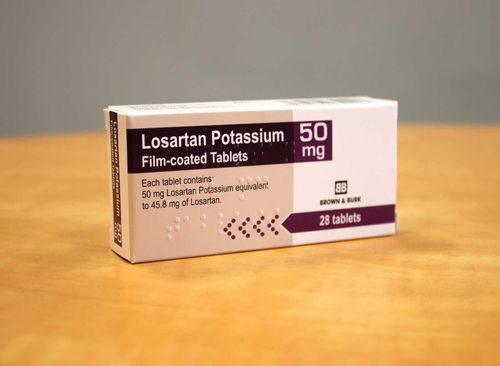This is an automatically translated article.
Langitax is a drug commonly prescribed for the prevention of deep vein thrombosis, helping to reduce the risk of stroke and embolism in patients with heart disease. So what is the active ingredient Langitax and what are the contents?
1. What is Langitax?
Langitax drug is a product of the branch of Phong Phu Pharmaceutical Joint Stock Company of the Usarichpharm pharmaceutical factory. The product is prepared in the form of film-coated tablets with the main active ingredient being Rivaroxaban 10mg, 15mg and 20mg, in addition, Langitax drug ingredients also include a number of excipients just enough for 1 tablet.
2. Mechanism of action of the drug Langitax
2.1. Pharmacodynamics The active ingredient rivaroxaban in Langitax is a selective inhibitor of clotting factor Xa without the need for any other cofactors. Langitax inhibits the activity of prothrombinase and free clotting factor Xa without direct effect on platelet aggregation, however Langitax can still indirectly inhibit platelet aggregation through the inhibitory pathway. thrombin generation.
2.2. Pharmacokinetics Absorption:
The bioavailability of rivaroxaban is dose dependent. When taking Langitax 10mg, bioavailability is about 80-100% and is not affected by food. When Langitax 20mg was administered with a fat-free meal, bioavailability was only about 66%. Food binding increases the bioavailability of rivaroxaban at a dose of 20 mg; Peak plasma concentrations of Langitax are reached 2-4 hours after dosing and the pharmacokinetics of rivaroxaban are not affected by drugs that alter gastric pH. Distribution:
Langitax is highly bound to plasma proteins (about 92 to 95%), mainly Albumin; The steady-state volume of distribution in healthy subjects is approximately 50 L. Metabolism:
Approximately 1% of an oral dose of [C]-rivaroxaban is recovered as inactive metabolites in urine (approximately 30%) and feces (approximately 21%), with the remainder excreted unchanged. change; Metabolism of rivaroxaban via oxidation reactions catalyzed by CYP3A4/5 and CYP2J2 and hydrolysis. Elimination:
Approximately 2⁄3 doses of rivaroxaban are eliminated as inactive metabolites in feces and urine. The remaining 1⁄3 will be eliminated directly as unchanged active substance in the urine, mainly through active renal excretion.
3. Indications of the drug Langitax
Langitax is indicated in the following cases:
Langitax helps limit the risk of stroke and systemic embolism in people with non-valvular atrial fibrillation; Langitax is used in the treatment of deep vein thrombosis or pulmonary embolism; Rivaroxaban reduces the risk of recurrence of posterior venous thrombosis and pulmonary embolism after 6 months of treatment; Langitax is also used for the prevention of deep vein thrombosis in patients undergoing knee surgery or hip fracture.
4. Dosage instructions and how to use Langitax
How to use:
Patients need to take Langitax tablets whole, absolutely do not chew, break or crush the drug; Langitax 15 and Langitax 20mg need to be taken with food and Langitax 10 can be taken with or without food. The usual recommended dose of Langitax:
Reduces the risk of stroke and systemic embolism in patients with nonvalvular atrial fibrillation: The dose of Langitax depends on renal function, specifically as follows: Creatinine clearance (CrCl) over 50 ml/min: 1 Langitax 20mg tablet taken only once a day at dinner; CrCl from 15 to 50 ml/min: 1 Langitax 15 tablet 1 time/day at dinner; Treatment of deep vein thrombosis, pulmonary embolism: Take 2 times a day, take 1 Langitax 15 tablet each time with food for 21 days, then maintain 1 time a day, 1 Langitax 20mg tablet each time. with food; Limit the risk of recurrence of deep vein thrombosis and pulmonary embolism: Take 1 tablet of Langitax 20mg each time with food; Prophylaxis of deep vein thrombosis in people undergoing knee or hip replacement surgery: Hip replacement: Take 1 tablet of Langitax 10 each time for 35 days; Knee replacement: Take 1 time a day, 1 tablet of Langitax 10mg each time for 12 days. In case of switching from Warfarin to Langitax: Patients need to stop Warfarin and start Langitax as soon as the INR test is below 3.0 to avoid an incomplete anticoagulation period.
Cases needing to switch from other anticoagulants Warfarin to Langitax : Patients on treatment with anticoagulants other than Warfarin (such as low molecular weight heparin or non-warfarin oral anticoagulants) need to start Langitax 0-2 hours before the evening dose of the daily dosing schedule and stop taking other anticoagulants. In case of continuous infusion of unfractionated Heparin, the patient should be discontinued and Langitax started immediately.
5. Contraindications of the drug Langitax
Langitax is contraindicated in the following cases:
People with a history of allergy or hypersensitivity to rivaroxaban or any of the ingredients in Langitax; Patients with bleeding disorders or clinically at risk of bleeding should not use Langitax ; Severe renal impairment with creatinine clearance less than 15 ml/min; Moderate to severe liver failure or any liver disease affecting blood clotting; Pregnant women.
6. Some cautions when using Langitax
Risk of blood clots: Patients with early discontinuation of oral anticoagulants (including Langitax) have a higher risk of thromboembolism, and the risk of stroke has been noted during the transition. switching from rivaroxaban to warfarin in trials in patients with atrial fibrillation. In the event that Langitax needs to be discontinued, for a reason other than bleeding or has completed the course of treatment, another anticoagulant should be considered.
Risk of bleeding: As with other anticoagulants, patients taking Langitax should be carefully monitored for signs of bleeding. Besides, the use of Langitax drug should be especially cautious in patients at high risk of bleeding such as:
Congenital or acquired bleeding disorders; Severe uncontrolled arterial hypertension; Gastrointestinal disease without active ulceration and potential bleeding risk (eg, enteritis, esophagitis, gastritis or gastroesophageal reflux disease); Vascular retinopathy; Bronchiectasis or people with a history of pulmonary hemorrhage. These patients should be carefully monitored for signs and symptoms of bleeding and anemia after initiating treatment with Langitax. People who are using Langitax should be aware that an unexplained drop in hemoglobin or low blood pressure needs to quickly locate the bleeding site.
Use Langitax in patients with renal impairment:
In patients with severe renal impairment (creatinine clearance less than 30 ml/min), the concentration of rivaroxaban can be significantly increased, thereby increasing the risk of bleeding; Do not use Langitax for patients with CrCl less than 15 ml/min; Closely monitor and promptly evaluate any signs of blood loss in patients with CrCl 15-20 ml/min during the use of Langitax; Discontinue Langitax in patients with acute renal failure; Langitax should be used with caution in patients with moderate renal impairment (CrCl 30-40 ml/min) and concomitant use of drugs that may increase blood levels of rivaroxaban. Use of Langitax in patients with prosthetic heart valves: The safety and effectiveness of Langitax have not been studied in this patient population, and therefore, Langitax is not recommended.
Use of Langitax for pulmonary embolism in patients with hemodynamic instability or indications for thrombolysis or dilation: Langitax is not recommended as a substitute for unfractionated heparin in this case due to safety reasons. and efficacy has not been established.
People with indications for spinal anesthesia (including epidural or spinal anesthesia):
When anaesthesia or lumbar puncture in patients receiving anticoagulants such as Langitax (for thromboprophylaxis purposes) venous occlusion) increases the risk of hematoma in the spinal cord or epidural, leading to prolonged paralysis. This risk is even higher in people with epidural catheters or concomitant use of drugs that affect hemostasis; The above risk is also increased in people with spinal cord injury or repeated epidural puncture; Physicians must regularly monitor patients for symptoms of neurological impairment (such as numbness or weakness in the legs, bladder and colon dysfunction) in patients. If abnormality is detected, the patient should be diagnosed and treated promptly; Physicians should weigh the benefits and risks before administering spinal anaesthesia in patients receiving Langitax anticoagulants or in patients requiring anticoagulation for thromboprophylaxis. Also do not remove the epidural catheter earlier than 18 hours after the last time Langitax was administered and do not use Langitax earlier than 6 hours after the catheter was removed. If a puncture injury occurs, the patient should delay administration of Langitax for the following 24 hours. Elderly patients should use Langitax with caution due to the higher risk of bleeding.
Effects of Langitax on Driving and Using Machines: Syncope and dizziness associated with Langitax have been reported and may affect the ability to drive and use machines. This warns people using Langitax that if they experience the above side effects, they should not drive or do work that requires alertness.
Use of Langitax during pregnancy: There are no data on the safety and efficacy of rivaroxaban in this population. Animal data have shown that rivaroxaban crosses the placental barrier; therefore, Langitax is contraindicated for use during pregnancy.
Use of Langitax during lactation: There are no data on the safety and efficacy of rivaroxaban in this population. Animal studies have shown that Langitax may be excreted in human milk, therefore it is recommended that nursing mothers be discontinued while using Langitax.
7. Unwanted effects of the drug Langitax
The most common side effect of Langitax is bleeding. In addition, the following adverse reactions have been reported with an incidence of ≥ 1% in the voluntary group of Langitax users:
Fatigue; Epigastric pain; Toothache; Retroperitoneal bleeding; Sinusitis, urinary tract infections; Back pain, osteoarthritis, headache, muscle spasms; Sore throat; Neurological disorders such as syncope, cerebral hemorrhage, epidural hematoma, hemiplegia; Pruritus, urticaria, Stevens Johnson syndrome; Agranulocytosis, thrombocytopenia; Jaundice, cholestasis, hepatitis; Hypersensitivity, anaphylaxis, angioedema. Patients need to quickly inform their doctor about the unwanted effects encountered when using Langitax.
Instructions on how to manage ADR:
Stop using the drug; Mild adverse reactions usually necessitate discontinuation of Langitax ; In severe cases or allergic reactions, the patient needs supportive treatment, including ensuring airway clearance, using adrenaline, breathing oxygen, antihistamines, corticosteroids...
8. Interaction of Langitax with other drugs
Interactions of the drug Langitax with inducers of Cytochrome P450 3A4 inhibitors and drug delivery systems:
Inducers of P-gp and CYP3A4 (Rifampicin, Phenytoin, Carbamazepine, Phenobarbital...) have the potential to reduce plasma concentrations. rivaroxaban plasma levels, reducing the therapeutic effect of the drug Langitax. P-gp and CYP3A4 inhibitors (Ketoconazole, Itraconazole, Lopinavir/Ritonavir, Indinavir, Clarithromycin, Erythromycin) increase rivaroxaban plasma concentrations, leading to an increased risk of bleeding for patients. In a drug interaction study, a single dose of enoxaparin (40 mg subcutaneously) and rivaroxaban (10 mg) co-administered resulted in an increased factor Xa antagonist effect, in another single dose study. of Warfarin (15mg) and rivaroxaban (5mg) resulted in increased inhibition of factor Xa, PT.
Interactions of Langitax with NSAIDs/Aspirin: Concomitant use of aspirin (dose of 100 mg or less) has been identified as an independent risk factor for major bleeding, on the other hand NSAIDs are known to increase bleeding and the risk of bleeding is further increased when NSAIDs are used concomitantly with Langitax .
Interaction of Langitax with Clopidogrel: Co-administration of Clopidogrel with rivaroxaban will increase the bleeding time 2 times compared to using either drug alone.
9. Langitax overdose and how to handle it
Overdosage of rivaroxaban can lead to bleeding, in which case rivaroxaban should be discontinued and appropriate treatment instituted immediately if bleeding complications associated with Langitax overdose occur.
Currently there is no specific antidote for rivaroxaban, the use of activated charcoal to reduce absorption may be considered in case of rivaroxaban overdose. Due to the strong binding of rivaroxaban to plasma proteins, dialysis is not recommended. Administration of plasma products can significantly reverse anticoagulant parameters in vitro. Langitax is a drug commonly prescribed for the prevention of deep vein thrombosis, helping to reduce the risk of stroke and embolism in patients with heart disease. To ensure effective use, avoid side effects, patients need to strictly follow the instructions of the doctor, professional pharmacist.
Follow Vinmec International General Hospital website to get more health, nutrition and beauty information to protect the health of yourself and your loved ones in your family.
Please dial HOTLINE for more information or register for an appointment HERE. Download MyVinmec app to make appointments faster and to manage your bookings easily.













